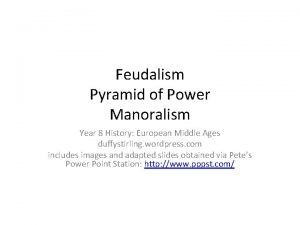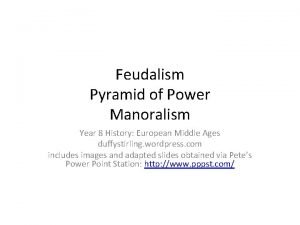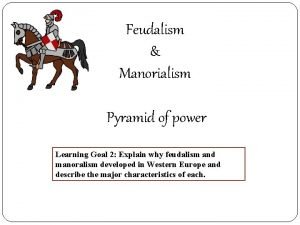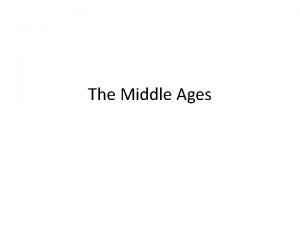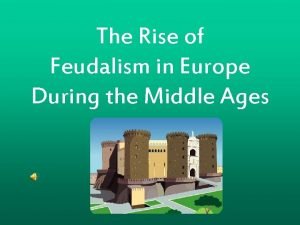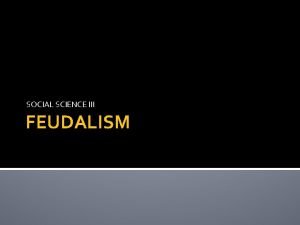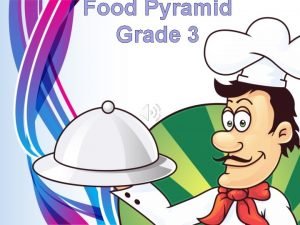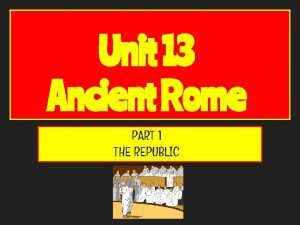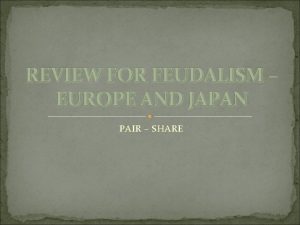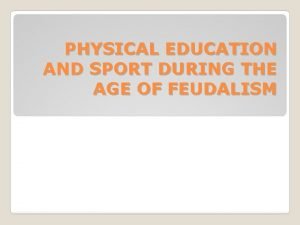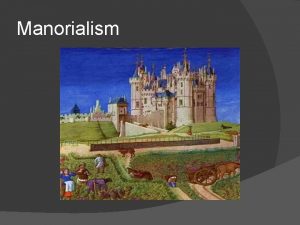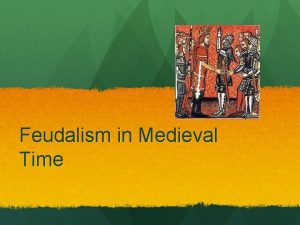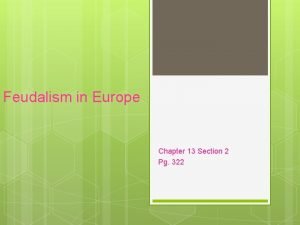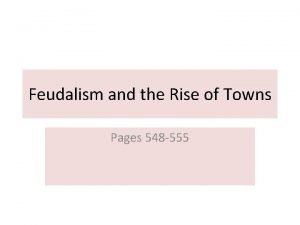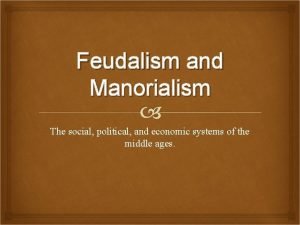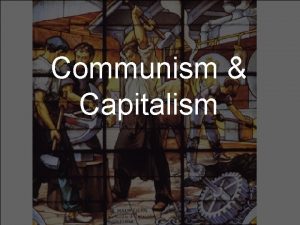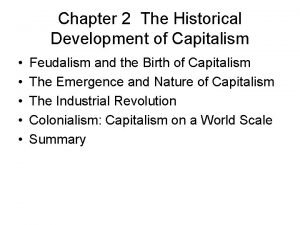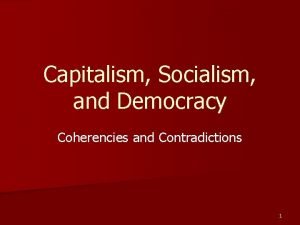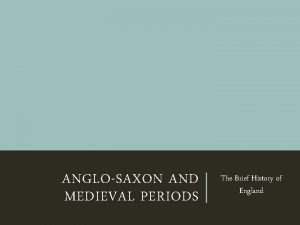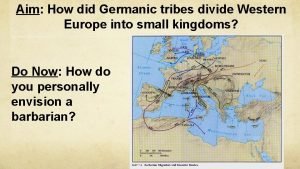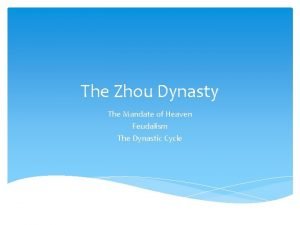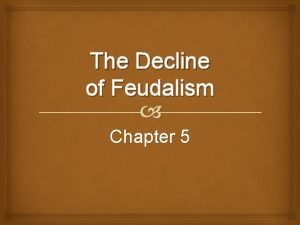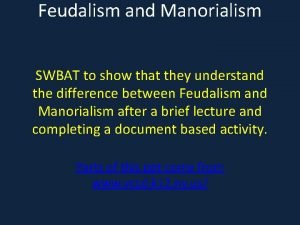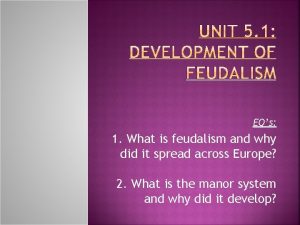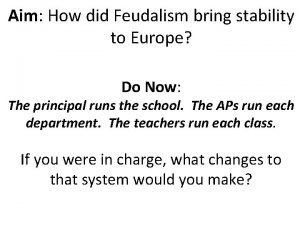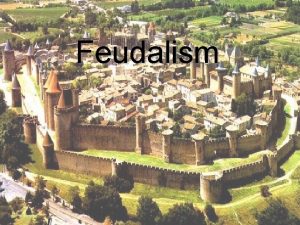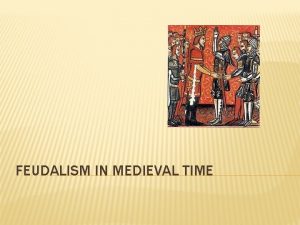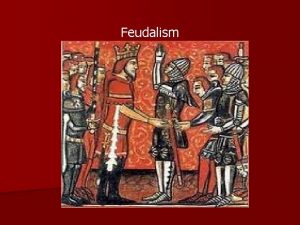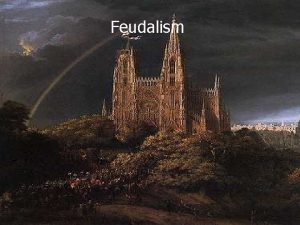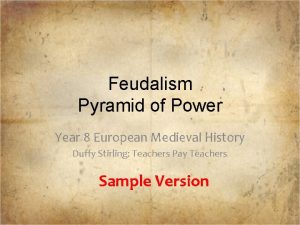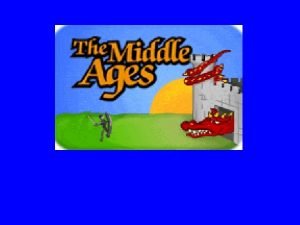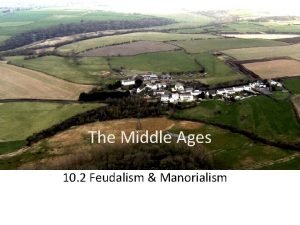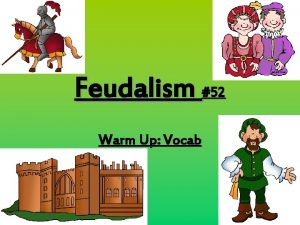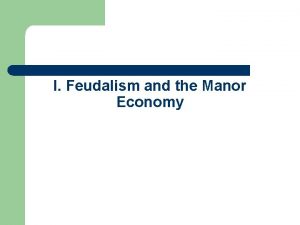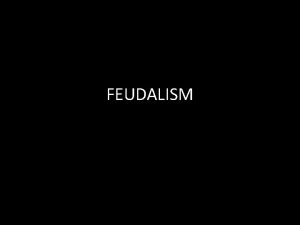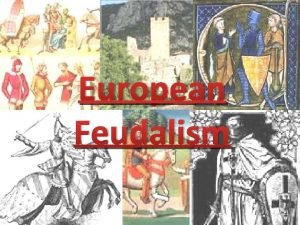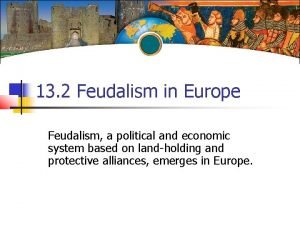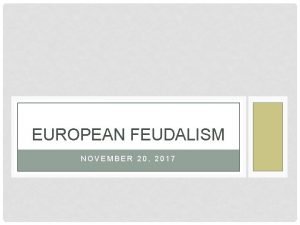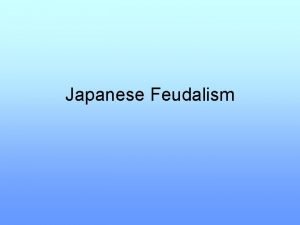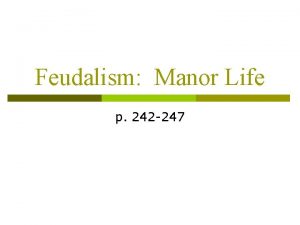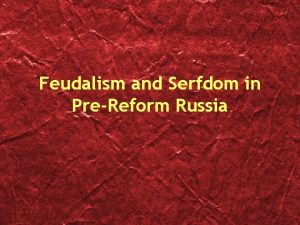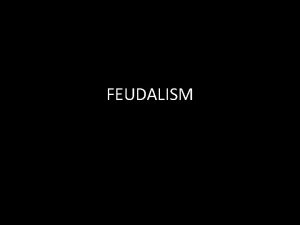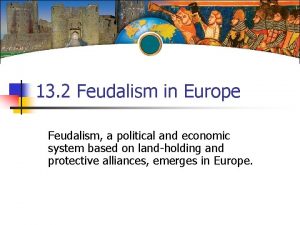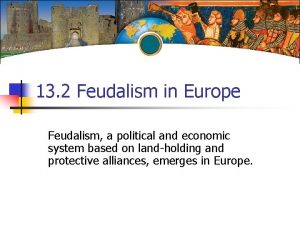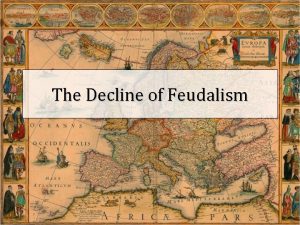Feudalism Pyramid of Power Manoralism Year 8 History































- Slides: 31

Feudalism Pyramid of Power Manoralism Year 8 History: European Middle Ages duffystirling. wordpress. com includes images and adapted slides obtained via Pete’s Power Point Station: http: //www. pppst. com/

Feudalism E. Napp The Early Middle Ages was a dangerous time.

Government in the Middle Ages • Roman Empire had a central government. • After Rome fell, Europe had dozens of little kingdoms. • Lots of fighting between kingdoms. • Lots of attacks from Vikings, Magyars (from East Asia) and Muslims. • A new way evolved. . .

Feudalism • Feudalism was the political and military system of the Middle Ages. • In a feudal society, land is exchanged for military service and loyalty. • The ownership of land was the basis or power. NEW PAGE: Title: Feudalism in the Middle Ages Copy this definition: Feudalism is a political system where land – and therefore money and power – is exchanged for military service and loyalty.

Feudal Pyramid of Power

At the top The King owned all of the land. Depending on how much he liked them, he gave land to the Nobles. William the Conqueror

KING LA ND NOBLES Feudal Pyramid of Power

Nobles • Lords and Ladies, Dukes, Earls. • Usually related to, or mates with, the King. • They didn’t get the Land for free: they were required to give money and soldiers (knights) if the King needed them to fight a war.

ND A EY TS N H O M KNIG KING LA ND NOBLES Feudal Pyramid of Power

Knights • Nobles needed trained soldiers to defend castles and to give the King when he asked for them. • Knights most important, highly skilled soldiers • Mounted knights in heavy armor best defenders

ND A EY TS N H O M KNIG N O I CT ARY E OT ILIT E R P d M VIC an SER KING LA ND NOBLES KNIGHTS Feudal Pyramid of Power

Knights BUT • Being a knight is expensive; – weapons, armor, horses • Nobles usually paid with land. • Land given to knight for service was called a fief – Anyone accepting fief was called a vassal – A vassal had to obey his Lord and fight for him when required.

ND A EY TS N H O M KNIG N O I CT ARY E OT ILIT E R P d M VIC an SER KING LA NOBLES ND LA ND (fie f) KNIGHTS vassals Feudal Pyramid of Power

Many Lords • Person could be both lord, vassal • Some knights with large fiefs gave small pieces of land to other knights • One knight could serve many lords • Everyone’s supposed to be loyal to the King. Didn’t always work out that way.

Peasants • Everyday people – peasants - were frightened. • They turned to landowners for protection. • Peasants offered their labor in exchange for protection. • These peasants were called serfs.

Serfs • A serf was “bound to the land. ” • He could not leave his lord’s land. • He was not a slave because he could not be sold. • But he was not free because he could not leave. • He also needed permission to marry.

ND A EY TS N H O M KNIG N O I CT ARY E OT ILIT E R P d M VIC an SER D N A S D O ICE O F ERV S KING LA NOBLES ND LA ND (fie f) an KNIGHTS vassals LA dp PEASANTS Feudal Pyramid of Power rot ND ec tio n

Manorialism In Modern times, when we say “Manor”, we mean this:

Manorialism But in the Middle Ages, a Manor was more like a town or a large estate. Remember: a fief was all of a Lord’s land. The Manor was the part of the fief where the peasants farmed and lived. In your book finish this sentence: In the Middle Ages, a fief was … A manor, in the Middle Ages, is …

Manorialism • Manorialism was the economic system of the Middle Ages. – These days our economic system is called ‘Capitalism’. • Manorialism is a self-sufficient economy; this means that everything that is necessary for life was created on the manor. • COPY and Answer this question in your book: What sort of things do Medieval People need for everyday life?

Manorialism • Manors had some free people who rented land from lord • Each manor included fortified house for noble family, village for peasants, serfs • Others included landowning peasants, skilled workers like blacksmiths, millers • Also had a priest for spiritual needs


Buildings ORCHARD

The Peasants • At the lowest level of society were the peasants, also called serfs or villeins. • The lord offered his peasants protection in exchange for living and working on his land.

Hard Work & High Taxes • Peasants worked hard to cultivate the land produce the goods that the lord and his manor needed. • They were heavily taxed and were required to relinquish much of what they harvested.

Serfs • A serf was “bound to the land. ” • He could not leave his lord’s land. • He was not a slave because he could not be sold. • But he was not free because he could not leave. • He also needed permission to marry.



Repairing fixing sheds, houses, fences Planting Weaving Ploughing Fertilising Sowing Weeding Pruning Shearing Scaring Birds Harvesting Gathering Tying Winnowing Milling Butchering Salting/ Smoking Collecting Digging

Vocab Match COPY the word and it’s correct definition into your book. serf A) a person who swears to be a fighter for a lord in exchange for land. feudalism B) the part of the fief in which villagers and peasants live (kind of like a small town) fief C) the system which involves residents of a manor growing and making everything for themselves (being self sufficient) manor D) a peasant which is tied to the land (kind of like a slave) vassal E) the political system which William the Conqueror set up which involves exchanging land for service. manorialism F) Land given to Knights and Lords in exchange for loyalty and a promise to fight.

ND A EY TS N H O M KNIG N O I CT ARY E OT ILIT E R P d M VIC an SER D N A S D O ICE O F ERV S KING LA NOBLES ND LA ND (fie f) an KNIGHTS vassals LA dp PEASANTS Feudal Pyramid of Power rot ND ec tio n
 European feudal system pyramid
European feudal system pyramid Feudal pyramid of power
Feudal pyramid of power Manorialism vs feudalism
Manorialism vs feudalism Manoralism def
Manoralism def European feudalism pyramid
European feudalism pyramid Social pyramid feudalism
Social pyramid feudalism Feudal society pyramid
Feudal society pyramid Real power formula
Real power formula Poem for school leavers
Poem for school leavers Food pyramid explained
Food pyramid explained 30 pack year smoking history means
30 pack year smoking history means Pack year history
Pack year history Elected only by plebeians, veto power, 1 year term
Elected only by plebeians, veto power, 1 year term Pyramid of energy
Pyramid of energy Japanese feudal hierarchy
Japanese feudal hierarchy Physical education in feudalism
Physical education in feudalism Primitive society physical education
Primitive society physical education What is manorialism?
What is manorialism? How feudalism worked
How feudalism worked Feudalism in europe chapter 13 section 2
Feudalism in europe chapter 13 section 2 Feudalism acrostic poem
Feudalism acrostic poem Manorialism
Manorialism Feudalism capitalism socialism communism
Feudalism capitalism socialism communism Feudalism vs capitalism
Feudalism vs capitalism Socialism capitalism hybrid
Socialism capitalism hybrid Sussex and wessex
Sussex and wessex How did germanic tribes divide western europe
How did germanic tribes divide western europe Mandate of heaven example
Mandate of heaven example The decline of feudalism chapter 5 answer key
The decline of feudalism chapter 5 answer key Manorialism pyramid
Manorialism pyramid Feudalism
Feudalism Feudalism
Feudalism
